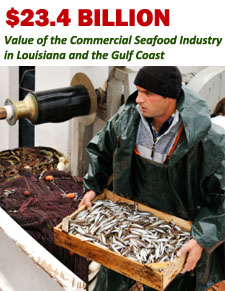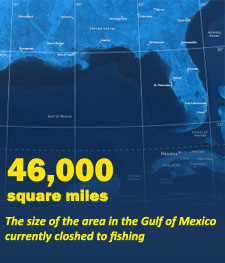The amount of oil that has now spewed into the Gulf of Mexico is now a stunning 17 million to 39 million gallons, according to U.S. Geological Survey director Dr. Marcia McNutt on Thursday – making it the worst oil leak in U.S history, far surpassing the 11 million gallons that leaked during the 1989 Exxon Valdez disaster. And scientists from all over the country are trying to assess the current and future damage.
Most experts now put the economic costs of the disaster at $10 to $14 billion – though no one knows for sure. (BP’s cleanup costs are estimated to be, as of now, roughly $760 million.) 
While the oil giant BP and the U.S. Coast Guard say that the “top kill” method of stanching the flow appears to be moving forward, BP cautions that it will be a few more days before they can confirm that it’s plugged the leak. Examining the live “spillcam” video, environmental sciences professor Ed Overton told MSNBC on Thursday morning that the plume now gushing from the broken well appears to be mud, rather than oil – a promising, but not definitive, sign.
More and more scientists, wildlife conservationists and others across the country are expressing their anger and alarm over the magnitude of the crisis and its far-reaching effects on the region’s natural resources. Dr. Edward Proffitt of the Harbor Branch Oceanographic Institute at Florida Atlantic University told The Fiscal Times that he worries about “mass mortality and then erosion of part of the coastal zone as the oil gets up there into the marshes and into the soft sub-strata. Once it soaks into the soft mud, it’s impossible to get out. It’s going to be there for awhile. It will degrade very slowly.”
Kacky Andrews, the National Oceanic and Atmospheric Administration’s manager for coral reef conservation, also told The Fiscal Times on Thursday, “I’m clearly concerned. Corals are under a number of different threats and stressors, but we simply don’t know what the impacts [of this spill] are going to be yet. Some deep-sea corals are among the longest living species on the planet — they can be 4,000 years old. These are remarkable resources, and they’re all over the gulf. The corals are in the line of the spill.”
National Parks Vulnerable
On Thursday, new worries emerged about the national parks. U.S. National Parks director Jonathan Jarvis said that more than 40 parks and wildlife refuges in the gulf could be affected by the spill, in ways still unknown. Teams of scientists have been sent to assess conditions, he said, and they’ve been looking not just at the spill’s impact, but at the effects of the dispersants that BP has been using.
Speaking about those dispersants, John Fitzpatrick, director of Cornell’s Lab of Ornithology, told The Fiscal Times, “Presumably they’re some form of detergent or solvent, and if they act as an emulsifier for crude oil in seawater, then they presumably have some potentially terrible effects on birds, both as direct poisons upon ingesting and, more important, as solvents that could disrupt or neutralize the natural oils all birds produce and depend upon, to keep their plumage functionally waterproof.”

Susan K. Avery, president and director of the Woods Hole Oceanographic Institution (WHOI), said in a statement that WHOI is helping to “measure [spill] flow rates, map plume dispersion, and provide high-density data and metadata in real time,” among other things. All of this work, she added, may “make this the most immediately and intensively studied oil spill in history.”
Still, so much remains unknown, particularly about the oil far below the surface. “It’s out of our view. You can’t track it very well, unlike the surface oil which you can see from an airplane,” Ed Proffitt told The Fiscal Times. The oil deep down is “covering very large volumes of water, and it’s probably already killing millions of small organisms, some of which are juvenile or larval forms of crabs and fish, things people really care about. Yet no one has the resources right now to be able to go down and study that.” He added, “You wouldn’t ever be able to clean that up, I don’t think. But if you had enough research dollars, you certainly should be able to.”
Proffitt added that “there are spills in and around the Louisiana coast all the time, but usually they’re of small magnitude and separated in time, unlike this one. I doubt they even try to clean [the small spills] up. They’re mostly ignored unless someone happens to see them or report them.”
What’s clearly not being ignored, however, is this oil disaster -- or even the one back in 1979, before some of those working on this leak were probably even born. The Ixtoc I leak also occurred in the Gulf of Mexico. For nine months, people tried in vain to cap the well. It was finally closed in March 1980.
With additional reporting by Blaire Briody.
Tell us what you think about this article, using the comment box below.



